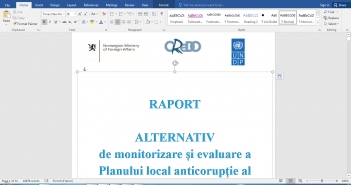Analiza comparată a transparenței Guvernului 2012-2014 v. 2016[EN]
Analiza comparată a transparenței Guvernului 2012-2014 v. 2016[RO]
Analiza comparată a transparenței Guvernului 2012-2014 v. 2016[RU]
Government decisions transparency monitoring
On the basis of the weekly opinions that contain a section on the transparency of the Government. The annual report on Transparency has been discussed during the Annual Conference of the civil society on one side and the Government and Parliament on the other side. The project presented also a key position on the future role of the civil society and the way to participate in the consultation process and platform with the Government and Parliament.
Research and Presentation of the Comparative Analysis of the Transparency of the Government 2016 vs 2012-14 . http://www.credo.md/pageview?id=587, and http://www.credo.md/site-doc/CReDO_Transp_2016_v6(2).pdf.
The research is the only of this kind elaborated and presented in public that also contains the comparative analysis of the situation with the past 2 years.
The core conclusions of the Transparency of the Government report are:
Failure to observe the consultation requirement at the decision drafting stage. No improvement as compared to 2014 of the transparency. 32.4% of the subjects put on the agendas of Government meetings did not fully observe the consultation procedure, i.e. were not identified on the website of the responsible institution and the portal www.particip.gov.md or were not posted for a 15 day term as provided by the Law on Transparency in Decision Making. 2. Transparency requirement avoided via the procedure of endorsing legal acts initiated by MPs. For this category of decisions, there is currently no single decision-making transparency mechanism in place. Hence, the central public authorities avoid subjecting such endorsements to the transparency procedure, thus promoting onto the agenda of the Cabinet of Ministers important draft laws unsubjected to the transparency procedure. 4. Systematic practice of failing to subject acts to the anticorruption expertise is attested by the fact that over 9% of the drafts liable to this procedure had not been sent for expert examination by the authors and were included in the meeting for examination by the Cabinet of Ministers without having conducted the mandatory anticorruption expertise. 5.Possible causes that explain the lack of full transparency that persist in decision drafting and making: Implicit interpreting of exceptions from the decision making transparency procedure; Ambiguity and declarative character of the requirements for transparency in decision-making; Inefficiency and unclearness of the mechanisms for invalidating decisions in the conditions of non-observance of transparency requirements (by establishing the superior body and at the stakeholder’s request); Inefficiency of the mechanisms of individual accountability for failure to observe the transparency requirements; Inadequate capacities for observing the transparency requirements (skills, technologies); High costs for conforming to the transparency requirements.
The report and the discussions have been widely reflected in the press. See the links below.
Mass Media
Versiunea completă și finală a raportului va fi publicată în următoarele zile
4 iulie live conf
http://realitatealive.md/live-are-loc-a-vii-a-edi-ie-a-conferin-ei-anuale-cooperarea-dintre-parlament-si-societatea-civila-participa-pavel-filip-i-andrian-candu_41813.html
http://www.prime.md/rom/news/social/item37635/
http://www.moldpres.md/news/2016/07/05/16005442
http://www.realitatea.md/societatea-civila--divizata-in-doua-tabere---pro-si-contra-consiliului-national-de-participare--parlamentul--dati-ne-posibilitatea-sa-comunicam-cu-acea-platforma--video-_41810.html
http://www.realitatea.md/asigurarea-unei-coordonari-eficiente-a-asisten-ei-oferite-de-partenerii-de-dezvoltare-discutata-de-pavel-filip-i-reprezentan-ii-societa-ii-civile_41811.html











